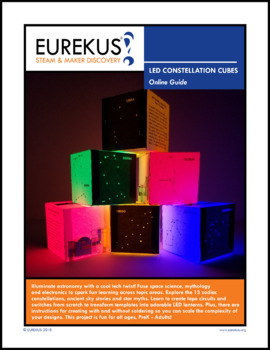LED Constellation Cubes - STEAM Guide
- PDF
Description
ACCESS WITH OUR HANDY ONLINE LEADER PORTAL!
Enjoy this engaging program with our new, easy-to-use online tools. Illuminate astronomy with a cool tech twist! Fusing space science, mythology and electronics, Constellation Cubes spark fun learning across topic areas. Explore the 13 zodiac constellations, ancient sky stories & cultural star myths. Learn to create tape circuits and switches from scratch to transform paper templates into adorable LED lanterns. There are instructions for creating 2 versions of the project to scale for different ages and skill levels - a basic version that does not require soldering and a more complex version with soldering. This project is fun for all ages and is awesome for family, adult and school events.
- Ages: K-12th Grade & Adult Makers; Younger makers require adult help
- Skills: Astronomy, mythology, engineering, circuits & electronics, geometry
- Time: 90 min - 2 hours
- Format: In-Person or Virtual Learning
- Tech Requirements: Instructions included for making with or without solder
ONLINE TEACHING GUIDE INCLUDES
When you order this resource, you will get an introductory PDF one-sheet with a link to our Leader Portal. There you will find all the digital resources to learn and implement this program.
- Full Curriculum & Project Guide
- Link to Leader Webpage
- Supply Planners & Ordering Links
- 13 PDF Zodiac Cube Templates
- PDF Sky Stories Fun Fact Cards
- Handouts & Resources
- Video Tutorials & Slideshow Instructions
- Solder & No Solder Versions
- Tips for Working With Electronics
- Curricular Integrations
- Scaling & Scaffolding Ideas
- Trouble-Shooting Tips
- Samples of Student Work
- Common Core & NGSS Standards
LEARN MORE
STAY CONNECTED!





